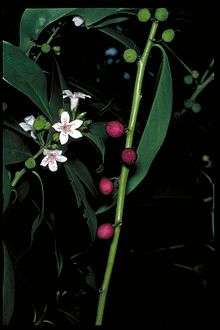Myoporum obscurum
Myoporum obscurum, commonly known as popwood, sandalwood or bastard ironwood is a plant in the figwort family, Scrophulariaceae. It is a very rare shrub, endemic to Norfolk Island where it occurs in a few scattered locations.
| Popwood | |
|---|---|
 | |
| Scientific classification | |
| Kingdom: | Plantae |
| Clade: | Tracheophytes |
| Clade: | Angiosperms |
| Clade: | Eudicots |
| Clade: | Asterids |
| Order: | Lamiales |
| Family: | Scrophulariaceae |
| Genus: | Myoporum |
| Species: | M. obscurum |
| Binomial name | |
| Myoporum obscurum | |
Description
Myoporum obscurum is a spreading shrub or small dome-shaped tree which sometimes grows to a height of 6 metres (20 ft). The leaves are arranged alternately and are thin, elliptic to lance-shaped, 69–135 millimetres (3–5 in) long, 25–40 millimetres (1–2 in) wide, have a shiny upper surface and a dull lower one with a distinct mid-vein. The edges of the leaf are wavy and occasionally have a few small teeth near the end.[2][3][4]
The flowers appear in groups of 3 to 6 in the axils of the leaves on the end of flattened stalks 6.5–11 millimetres (0.3–0.4 in) long. They have 5 lance-shaped sepals and 5 petals joined at their bases to form a tube. The tube is 4–6 millimetres (0.16–0.24 in) long and the lobes are about the same length as the tube. The tube is white, spotted purple on the lobes and inside the tube and the inside of the tube is hairy. There are 4 stamens which extend slightly beyond the petal tube.The fruit is an oval-shaped, reddish drupe.[2]
Taxonomy and naming
Myoporum obscurum was first formally described in 1833 by Stephan Endlicher and the description was published in Prodromus Florae Norfolkicae. The type specimen was found on Norfolk Island by Ferdinand Bauer.[5][6] The specific epithet is derived from the "Latin obscurum, indistinct, dark".[2]
Distribution and habitat
Only a few specimens of Myoporum obscurum remain and only in a few scattered locations on Norfolk Island.[2] The species was common on nearby Phillip Island in 1830, but along with most of the rest of the vegetation there, was lost in the 19th century due to erosion caused by the introduction of pest animals such as rabbits.[7] In 2003 only 5 plants were known on Norfolk Island,[8] all in the national park. Since then a management plan for the species has been prepared and a number of specimens of popwood have been planted. It does not tolerate shade and is generally found on forest margins.[9]
Ecology
Little is known of the ecology of popwood, other than it is threatened by competition from weed species.[9]
Conservation
Myoporum obscurum is listed as "critically endangered" in terms of the Australian Government Environment Protection and Biodiversity Act.[4]
References
- "Myoporum obscurum". Australian Plant Census. Retrieved 11 July 2019.
- Chinnock, R.J. (Bob) (2007). Eremophila and allied genera : a monograph of the plant family Myoporaceae (1st ed.). Dural, NSW: Rosenberg. pp. 114–115. ISBN 9781877058165.
- "Myoporum caprarioides Slender myoporum" (PDF). Government of Western Australia, Department of Water. Retrieved 1 September 2015.
- "Plants of Norfolk Island National Park and Botanic Garden" (PDF). Australian Government Director of National Parks. Retrieved 25 November 2015.
- "Myoporum obscurum". APNI. Retrieved 11 July 2019.
- Endlicher, Stephan (1833). Prodromus Florae Norfolkicae. Vienna. pp. 54–55. Retrieved 25 November 2015.
- Coyne, Peter (2009). Incredible! : the amazing story of the birth and rebirth of a natural treasure : Phillip Island, South Pacific (1st ed.). Belconnen, A.C.T.: Petaurus Publishing. pp. 43–69. ISBN 9780980652802.
- Coyne, Peter (2009). Norfolk Island's Fascinating Flora (1st ed.). Belconnen, A.C.T.: Petaurus Publishing. p. 66. ISBN 9780980652802. Retrieved 25 November 2015.
- Norfolk Island Region Threatened Species Recovery Plan (PDF). Canberra: Department of the Environment, Water, Heritage and the Arts, Canberra. 2010. p. 103. ISBN 9780646537634. Retrieved 25 November 2015.
